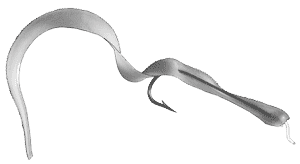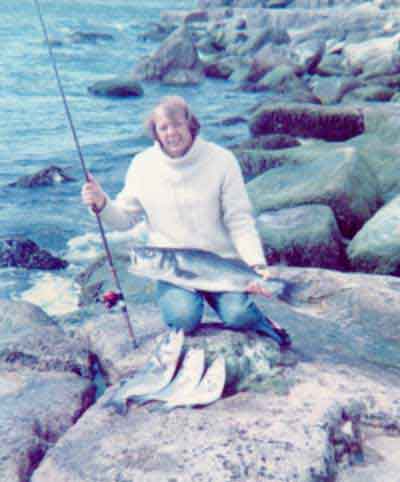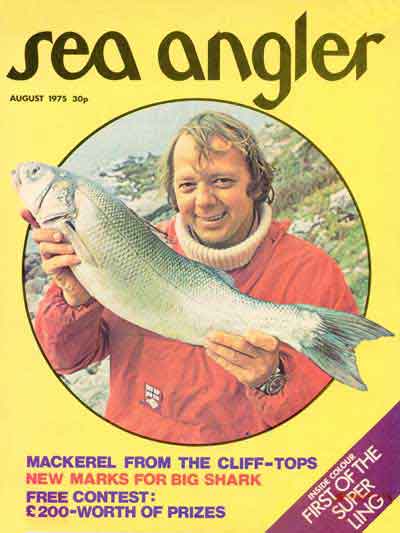 Whilst Alex Ingram was busy producing the prototype Red Gill, I was having
Whilst Alex Ingram was busy producing the prototype Red Gill, I was having  more than reasonable success catching Pollock and Bass using a large, almost translucent preserve jar, sealing ring. This was mounted on a #6/0 fine wire hook at the end of a 1·5m hook trace of 4.5kg Maxima line. Discovering the manufacturing company, Porosan DIY Ltd, was already in the process of closing the production line in their Chichester factory, I visited them to discuss a joint venture producing the rings as fishing lures.
more than reasonable success catching Pollock and Bass using a large, almost translucent preserve jar, sealing ring. This was mounted on a #6/0 fine wire hook at the end of a 1·5m hook trace of 4.5kg Maxima line. Discovering the manufacturing company, Porosan DIY Ltd, was already in the process of closing the production line in their Chichester factory, I visited them to discuss a joint venture producing the rings as fishing lures.
However, in 1972 my discussions with Porosan came to an abrupt end after I was given four sample 172mm Red Gills in a brown paper bag by a local tackle shop owner who was a friend of Alex Ingram. Although told they were boat lures, I rigged them up in the same manner as the Porosan eel, having no idea what was in store for me. As soon as I started casting them into the deep water skirting the huge rocks on the west side of Portland in the spring of 1972, I started landing more Bass than Pollock.
With the general release of the Red Gill in the summer of 1973 it soon became the "must have lure" as it broke record after record, and also put me on the map as a light line lure angler of some repute.
Angling Times, June 1973 - Bob Alexander staged a one-man war of the bass that frequent the rocks around Portland when he made a sortie to the windswept outcrop and took four fish, the biggest a rod bending 12lb 4oz. Bob, himself a Dorset man, knows the area well and had the course of action well planned when he clambered from rock to slippery rock in the search for the bass which feed in the foam filled gullies.
Using a home made spinning rod and closed-face AbuMatic reel loaded with 10lb line, he worked a Red Gill through the surf to take his first fish, a sample of 3lb 11oz.
Moving to another spot he hooked into a 5lb 14oz bass which put up a terrific fight before coming to the net. He continued the hunt at a rocky spot covered in swirling foam and after only six casts he hooked into a 3lb 12oz fish.
Then he had thoughts of going home, but decided to try one more rocky outcrop. He found a calm area among all the turbulence and cast out again to take the best fish of the day, a splendid bass of 12lb 4oz.
At first Bob thought he had hooked the bottom, but a frightening curve in his rod top soon dispelled that idea. A 15-minute battle followed, with the bass plunging to the sea bed and rolling on the surface. As Bob tried to beach the fish, his landing net handle collapsed, but he managed to haul it safely up on the rock.
After the capture, Bob said: "I have fulfilled a lifetimes ambition in catching that many good bass in an afternoon. I got soaking wet and by the end of the day I was exhausted, but it was worth it." Angling Times June 1973.
European record
A month or so after this I received a letter and small shield from the European Angling Federation congratulating me for setting a new 10lb Line Class, Bass Record. Unbeknownst to me, Jim Churchouse, the secretary of Weymouth Angling Society had submitted details of the fish along with a sample of line and fish scales to the European Federation.
The fish also won me a place in the Angling Times Annual fishing holiday, which that year took place in Weymouth, although not sleeping in the hotel as it was so close to home, during that week I met most of the angling journalists of the time, including the Editor of the Angling Times. After a brief discussion it was arranged that a journalist and photographer would come spinning with me over a weekend to get enough information for three articles to be published in the spring of 1974. To ensure we had some fish to photograph, Michael Monroe, a fishing friend of mine, decided to fish Portland Bill and meet up with us later for the photo shoot. Typically, on that morning I did not catch any bass under West Cliff, but thankfully Mike had a good morning and turned up with 3 nice Bass which were duly used under the direction of photographer Clive Nicholls.
Catching another double figure bass, by the autumn of that year I had also won a fishing hamper full of spirits; gold, silver and bronze tie pins from ABU and a ABU 5000 multiplying reel.
Sponsorship and journalism
Being invited to write for the Angling Times in the spring of 1975, I submitted three short illustrated articles that were well received; resulting in me being offered other freelance work with other angling and boating journals in the same publishing house. As it meant both typing and illustrating them, by the end of that year I had decided the publishing world was not for me.
three short illustrated articles that were well received; resulting in me being offered other freelance work with other angling and boating journals in the same publishing house. As it meant both typing and illustrating them, by the end of that year I had decided the publishing world was not for me.
During this period I was very flattered to receive a number of requests to give presentations to angling clubs, act as a paid guide and be sponsored by Diawa UK, none of which I felt able to accept. At that time, political strife and strikes made it difficult enough to support my young family and mortgage without the distractions of fishing and self employment.
With Clive Nicholls having the copyright of the images taken over that weekend in 1973, although aware some had been used in other European angling journals and advertisements, I was nonetheless surprised to be told by my sister-in-law that I was on the cover of the Sea Angler in the August of 1975 holding up one of Michael Monroe's Bass.
By the end of 1979, spinning from the shore with my 9ft single hand rod and AbuMatic 170 reel, I had caught 2 more double figure Bass from under the West Cliffs of Portland, 2 from Chesil beach, and 2 from the narrows of the fleet, giving me a total of 7 double figure bass in 6 years (all smaller than the first). By then I was also spinning from my boat on the shoals of bass that gathered in the spring off Portland Bill, using an Abu Atlantic 403 rod and AbuMatic 170 reel still loaded with 10lb Maxima mono. When the Bass shoals suddenly disappeared, I sold my boat, changed employers to get more free time and went back to  spinning from the rocks.
spinning from the rocks.
Now that I am retired, although being restricted to spinning in places that are easily accessible, I find pleasure in meeting and chatting to visiting lure anglers that holiday around Weymouth and Portland. My lending out rig, a ABU Garcia Vendetta 10'0" (305cm) 10/30gr rod and Shimano reel loaded with light braid line, has been continually lent out over the last six years to struggling local anglers, always being returned in good condition—which prompted me to write and post this web site.
Oh, my record breaking single handed rod eventually snapped beyond repair and like many other things, got lost in house moves—but the Abumatic reel survives to this day, as do many of the friends I made.
